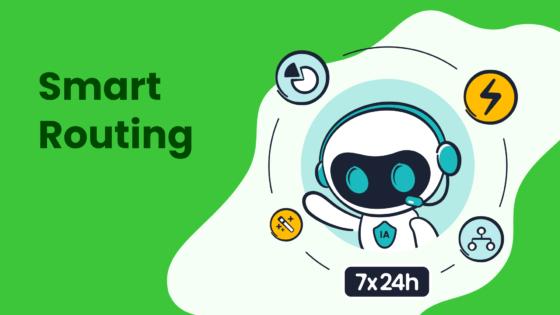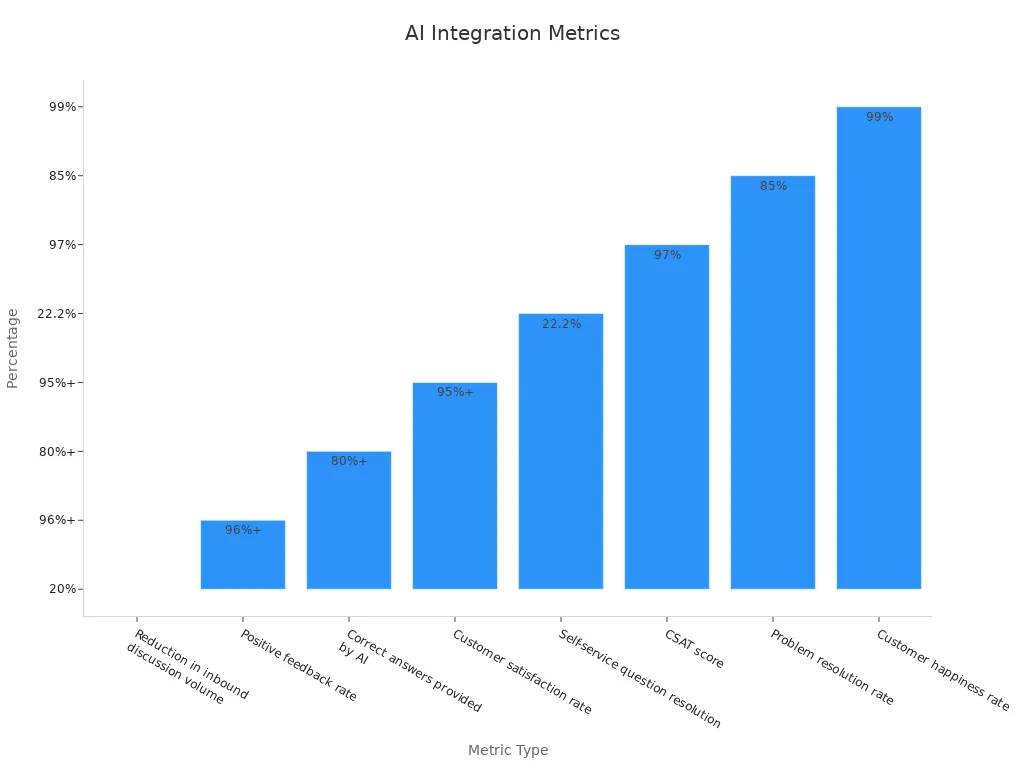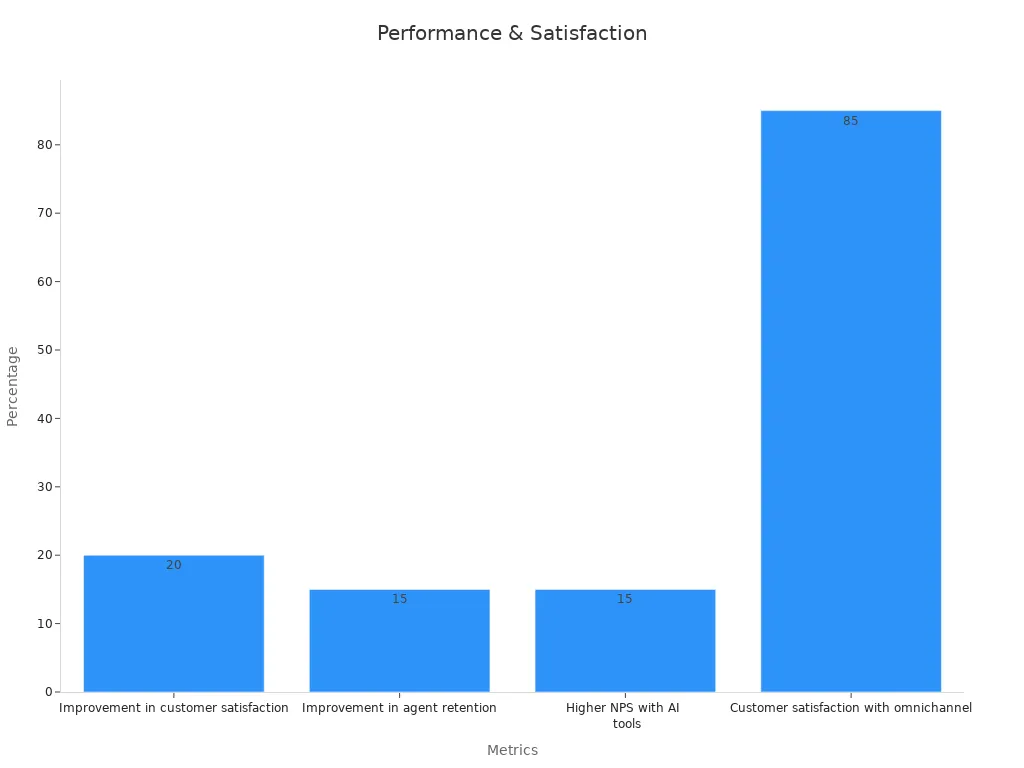5 Surprising Trends in Remote Customer Experience Jobs

Remote customer experience jobs are transforming how you interact with customers. With 40% of job seekers actively searching for fully remote roles, the demand for work-from-home opportunities is surging. Companies like Sobot are leading the way, helping you connect with the voice of the customer through cutting-edge tools. As technology and preferences shift, remote work is becoming the norm, offering flexibility and better earnings. On average, remote workers in the U.S. earn $19,000 more annually than their office-bound peers, showing the growing value of this evolving field.
AI-Powered Tools Are Redefining Remote Customer Experience

The Role of AI in Enhancing Remote Customer Service Jobs
AI is transforming how you handle remote customer service jobs. Imagine having a virtual assistant that works 24/7, answering questions, solving problems, and even predicting what customers might need next. AI chatbots do exactly that. They manage routine inquiries, provide instant responses, and free you up to focus on more complex tasks. This not only boosts your productivity but also improves customer satisfaction. For example, AI-powered tools can engage in human-like conversations, delivering accurate information faster than ever before. By automating repetitive tasks, you can spend more time building meaningful connections with customers.
How Sobot's Voice/Call Center Integrates AI for Smarter Interactions

Sobot’s Voice/Call Center takes AI integration to the next level. It uses features like AI-powered Voicebots to recognize customer intent and provide intelligent responses. The platform also offers smart call routing, ensuring customers are connected to the right agent quickly. Here’s how Sobot’s AI-driven solutions perform:
| Metric/Feedback Description | Value |
|---|---|
| Reduction in inbound discussion volume | 20% |
| Positive feedback rate | 96%+ |
| Correct answers provided by AI | 80%+ |
| Customer satisfaction rate | 95%+ |
| Self-service question resolution | 22.2% |
| CSAT score | 97% |
| Problem resolution rate | 85% |
| Customer happiness rate | 99% |

These numbers show how Sobot’s tools enhance remote customer experience by improving efficiency and customer feedback.
Online Community Insights on Adopting AI in Remote Roles
Online customer communities are buzzing about the benefits of AI in remote roles. Did you know that 56% of businesses now use AI for customer service? Even more impressive, 74% of business owners rely on AI-powered chatbots for instant messaging. These tools make it easier for you to work from home while delivering top-notch service. Employees across all age groups are also eager to learn generative AI skills, recognizing how essential they are for staying competitive in remote customer experience roles. The demand for AI isn’t just a trend—it’s the future.
Flexibility Is the New Standard in Remote Customer Service Jobs
Why Flexible Schedules Are Essential for Remote Teams
Flexibility has become a cornerstone of remote work. It’s not just a perk—it’s a necessity. Studies show that 71% of remote workers feel flexible schedules improve their work-life balance, while only 12% report any negative impact. This balance allows you to manage personal and professional responsibilities without feeling overwhelmed.
The demand for flexible work arrangements is growing rapidly. In fact:
- 82% of U.S. employees want to work remotely at least once a week.
- 19% prefer full-time remote roles.
- Only 8% would rather avoid working from home altogether.
This shift reflects how flexibility enhances productivity and satisfaction. When you can set your own schedule, you’re more likely to stay focused and deliver better results.
Tools and Strategies Shared by Online Communities for Managing Flexibility
Online communities are buzzing with tips to help you thrive in flexible remote roles. Here are some proven strategies:
- Use tools like Slack, Microsoft Teams, and Trello to stay organized and connected.
- Schedule regular check-ins with your team to maintain communication without micromanaging.
- Prioritize tasks using project management software like Asana.
- Embrace hybrid schedules if needed, as 25% of job postings now offer this option.
Experts like Katie Merritt emphasize that flexibility boosts both productivity and job satisfaction. It’s no wonder 64% of remote employees would consider switching jobs if flexibility isn’t accommodated.
How Sobot Supports Flexibility with Its Omnichannel Solutions
Sobot’s omnichannel solutions make flexibility seamless for remote customer service jobs. With a unified workspace, you can manage customer interactions across multiple channels—email, chat, and social media—all in one place. This integration reduces the need for constant switching, saving you time and effort.
The results speak for themselves:
| Metric | Value |
|---|---|
| Improvement in customer satisfaction | 20% |
| Improvement in agent retention | 15% |
| Higher NPS with AI tools | 15% higher |
| Customer satisfaction with omnichannel | 85% |

By streamlining workflows and offering AI-driven insights, Sobot empowers you to work smarter, not harder. Whether you’re handling inquiries or resolving issues, Sobot’s tools ensure you can deliver exceptional service while maintaining a flexible schedule.
Emotional Intelligence Is a Must-Have Skill
The Growing Importance of Emotional Intelligence in Remote Customer Experience
Emotional intelligence (EI) is becoming a game-changer in remote customer experience roles. It helps you connect with customers on a deeper level, making interactions more meaningful. Studies show that fewer than 20% of companies qualify as emotionally intelligent, yet those that do report stronger customer loyalty and advocacy.
| Findings | Insights |
|---|---|
| Fewer than 20% of companies qualify as emotionally intelligent. | Highlights the rarity and importance of EI in organizations. |
| 64% of emotionally intelligent companies have a high degree of empowerment and tolerance for risk. | Suggests a link between EI and empowering work environments. |
| Emotionally intelligent organizations report strong customer experiences, customer loyalty, and customer advocacy. | Directly correlates EI with enhanced customer experiences. |
| Companies that emphasize emotional intelligence experience higher levels of productivity and employee engagement. | Illustrates how EI impacts workplace productivity and engagement levels. |
Remote work amplifies the need for EI. Without face-to-face interactions, you rely on empathy and clear communication to resolve issues effectively. High EI also improves problem-solving and conflict resolution, making it essential for customer support representatives.
Tips from Online Communities on Developing Emotional Intelligence
You can develop emotional intelligence with simple, actionable steps. Online communities recommend these strategies:
- Assume positive intent to avoid misunderstandings.
- Listen more and focus on verbal and nonverbal cues.
- Identify and challenge biases to enhance inclusivity.
- Create a safe space for open dialogue and collaboration.
- Ask for feedback to improve your approach.
- Commit to fostering a psychologically safe culture.
These tips don’t just improve your interactions with customers—they also strengthen your relationships with teammates. By practicing empathy and active listening, you’ll become a more effective communicator in remote customer service jobs.
Leveraging Sobot's Unified Workspace to Foster Empathy in Customer Interactions
Sobot’s Unified Workspace makes it easier to apply emotional intelligence in remote roles. It consolidates customer data across channels, giving you a complete view of each interaction. This helps you understand customer needs and respond with empathy.
For example, when a customer reaches out via chat or email, Sobot’s platform provides context like past inquiries and preferences. You can tailor your responses, showing customers you value their time and concerns. This personalized approach boosts satisfaction and loyalty.
Sobot’s tools also streamline workflows, freeing you to focus on building connections rather than juggling multiple systems. With features like AI-driven insights and omnichannel integration, you can deliver exceptional service while fostering meaningful relationships.
Multilingual Talent Is in High Demand

Why Multilingual Skills Are Transforming Remote Customer Service Jobs
The rise of remote work has opened doors for multilingual professionals like never before. Companies are expanding globally, and they need people who can connect with customers in their native languages. This shift isn’t just about communication—it’s about building trust and creating seamless customer journeys. Bilingual and multilingual employees are now essential for businesses looking to enhance customer relations and tap into diverse markets.
Here’s why this trend matters:
- Employers are using global hiring services to find talent across borders.
- Time zone alignment is becoming a key factor in hiring decisions.
- The demand for multilingual employees is skyrocketing as businesses expand internationally.
For you, this means more opportunities to work remotely while leveraging your language skills. Whether you’re fluent in Spanish, Mandarin, or French, your ability to bridge cultural gaps makes you a valuable asset in remote customer service jobs.
Online Community Recommendations for Language Learning Resources
Want to boost your multilingual skills? Online communities have shared some fantastic resources to help you get started.
| Resource | Description |
|---|---|
| Harvard Graduate School of Education | Offers insights into second language learning and teaching strategies for multilingual learners. |
Other tips include:
- Using digital tools designed for language practice, like Duolingo or Babbel.
- Engaging with cultural content, such as movies or podcasts, in your target language.
- Participating in programs that involve your family’s native language to strengthen your skills.
These resources don’t just teach you new words—they help you understand cultural nuances, which is crucial for delivering exceptional remote customer experiences.
How Sobot's AI-Powered Voicebot Supports Multilingual Customer Interactions
Sobot’s AI-powered Voicebot is a game-changer for multilingual customer service. It recognizes and responds in multiple languages, making it easier for you to assist customers from around the world. The platform has already delivered impressive results:
- A 15%-35% increase in direct response rates.
- A 5%-15% boost in answer accuracy.
- An 80% reduction in the workload for maintaining knowledge bases.
For example, Renogy, a global solar energy company, saw a 35% jump in direct response rates and a 27% improvement in accuracy after adopting Sobot’s AI Agent. These tools don’t just make your job easier—they ensure customers feel understood, no matter where they’re from.
By combining your language skills with Sobot’s advanced technology, you can create smoother customer journeys and stand out in the competitive world of remote customer experience.
Remote Work Culture Is Shaping Customer Experience Teams
Building Strong Team Dynamics in a Remote Environment
Building strong team dynamics in a remote environment takes effort, but it’s absolutely doable. Trust is the foundation of any successful team, and in remote settings, it develops differently. Research shows that remote teams build trust through competence before personal connections. This means you need structured opportunities to showcase your skills and collaborate effectively.
To foster a cohesive team, try these strategies:
- Encourage active listening to build respect among team members.
- Create open feedback channels so everyone feels heard.
- Schedule regular check-ins to align goals and address concerns.
Teams that prioritize psychological safety also see up to 50% more engagement in discussions. When everyone feels safe to share ideas, collaboration thrives.
Online Communities’ Advice on Collaboration Tools for Remote Teams
Online communities are buzzing with tips on tools that make remote teamwork seamless. Companies like GitLab and Buffer have set great examples. GitLab, with over 1,300 remote employees, increased productivity by 50% using an open-source collaboration platform. Buffer, a remote-first company, achieved a 94% employee satisfaction rate by using tools like Slack for communication and Donut for team bonding.
Here are some tools you can explore:
- Slack: Perfect for instant communication and team updates.
- Trello: Great for managing tasks and tracking progress.
- Donut: Helps maintain social connections through virtual coffee chats.
These tools not only improve productivity but also help you feel connected to your team, no matter where you’re working from.
How Sobot's Solutions Enhance Remote Team Collaboration and Customer Satisfaction
Sobot’s solutions are designed to make remote customer experience teams more effective. With its omnichannel platform, you can manage customer interactions across email, chat, and social media in one unified workspace. This reduces the need to juggle multiple tools, saving you time and effort.
Sobot also provides AI-driven insights to help you prioritize tasks and improve response times. For example, its Voice/Call Center offers real-time monitoring and smart call routing, ensuring customers get the help they need quickly. These features not only enhance collaboration within your team but also boost customer satisfaction.
By using Sobot’s tools, you can streamline workflows, foster better teamwork, and deliver exceptional service—all while working remotely.
Remote customer experience jobs are transforming how you work and connect with customers. With 22.8% of employees now working remotely and over 35 million remote workers in the U.S., this shift is undeniable. Tools like Sobot's Voice/Call Center help you adapt by streamlining workflows and improving feedback. Embrace these trends to thrive in remote customer service jobs.
A study by Great Place to Work® found that productivity remained stable or even increased after transitioning to remote work.
FAQ
What skills are essential for remote customer experience jobs?
You’ll need strong communication, emotional intelligence, and problem-solving skills. Multilingual talent and familiarity with AI-powered tools like Sobot’s Voice/Call Center can also give you an edge.
How does Sobot help improve remote customer service?
Sobot’s tools, like its AI-powered Voicebot and omnichannel solutions, streamline workflows, enhance flexibility, and boost customer satisfaction by up to 20%. Learn more here.
Are remote customer experience jobs here to stay?
Yes! With 22.8% of employees working remotely and tools like Sobot making remote work efficient, this trend is growing. Remote roles offer flexibility and higher earnings.
See Also
Best Remote Call Center Companies To Work For
Advantages And Disadvantages Of Working Remotely In Call Centers
Discovering The Leading Cloud Contact Centers For 2025
Best Reviews Of Cloud Contact Center Services For 2024
AI-Powered Customer Service Agents Transforming Support Experience